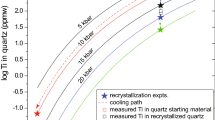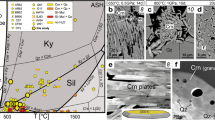Abstract
Examination of hydrothermally transformed silica from controlled experiments reveals that amorphous silica changes to quartz through an intermediate phase of opal-CT and that the d(101) spacing of cristobalite progressively decreases from 4.10 Å to 4.05 Å. The rate of spacing decrease is definitely dependent on the reaction temperature, being faster at higher temperatures. This spacing change represents ordering of opal-CT crystals with the passage of time.
The relationship between thermal history and degree of ordering suggests that stratigraphic boundaries are usually parallel to isopleths of d (101) spacings, but do not always coincide with them. The isopleths should be more or less discordant to the stratigraphic boundaries where the strata have been folded. This discordancy can be ascribed to the difference of ordering, chiefly controlled by the thermal history during the burial and folding process.
Similar content being viewed by others
References
Bettermann, P., Liebau, F.: The transformation of amorphous silica to crystalline silica under hydrothermal conditions. Contrib. Mineral. Petrol. 53, 25–36 (1975)
Ernst, W.G., Calvert, S.E.: An experimental study of the recrystallization of porcellanite and its bearing on the origin of some bedded cherts. Am. J. Sci. 267A, 114–133 (1969)
Flörke, O.W.: Der Einfluβ der Alkali-Ionen auf die Kristallisation des SiO2. Fortschr. Mineral. 32, 33–35 (1953)
Flörke, O.W.: Zur Frage des “Hoch”-Cristobalit in Opalen, Bentoniten und Gläsern. Neues Jahrb. Mineral. Monatsh. 217–223 (1955)
Flörke, O.W., Jones, J.B., Segnit, E.R.: Opal-CT crystals. Neues Jahrb. Mineral. Monatsh. 369–377 (1975)
Garrison, R.E., Rowland, S.M., Horan, L.J., Moore, J.C.: Petrology of siliceous rocks recovered from marginal seas of the Western Pacific, Leg 31, Deep Sea Drilling Project. In: Initial Reports of the Deep Sea Drilling Project (D.E. Karig et al., ed.), Vol. 31, pp. 519–529. Washington: U.S. Government Printing Office 1975
Greenwood, R.: Cristobalite: its relationship to chert formation in selected samples from the Deep Sea Drilling Project. J. Sediment. Petrol. 43, 700–708 (1973)
Heath, G.R.: Cherts from the Eastern Pacific, Leg 16, Deep Sea Drilling Project. In: Initial Reports of the Deep Sea Drilling Project (T.H. van Andel et al., ed.), Vol. 16, pp. 609–613. Washington: U.S. Government Printing Office 1973
Heydemann, A.: Untersuchungen über die Bildungsbedingungen von Quarz im Temperaturbereich zwischen 100°C und 250 °C. Beitr. Mineral. Petrog. 10, 242–259 (1964)
Jones, J.B., Segnit, E.R.: The nature of opal. I. Nomenclature and constituent phases. J. Geol. Soc. Australia 18, 57–68 (1971)
Jones, J.B., Segnit, E.R.: Genesis of cristobalite and tridymite at low temperatures. J. Geol. Soc. Australia 18, 419–422 (1972)
Keene, J.B.: Cherts and porcellanites from the North Pacific, DSDP Leg 32. In: Initial Reports of the Deep Sea Drilling Project (R.L. Larson et al., ed.), Vol. 32, pp. 429–508. Washington: U.S. Government Printing Office 1975
Kelts, K.: Summary of chert occurrences from Line Islands Sites 314, 315, 316 DSDP Leg 33. In: Initial Reports of the Deep Sea Drilling Project (S.O. Schlanger et al., ed.), Vol. 33, pp. 855–866. Washington: U.S. Government Printing Office 1976
Mizutani, S.: Transformation of silica under hydrothermal conditions. J. Earth Sci., Nagoya Univ. 14, 56–88 (1966)
Mizutani, S.: Kinetic aspects of diagenesis of silica in sediments. J. Earth Sci., Nagoya Univ. 15, 99–111 (1967)
Mizutani, S.: Silica minerals in the early stage of diagenesis. Sedimentology 15, 419–436 (1970)
Murata, K.J., Larson, R.R.: Diagenesis of Miocene siliceous shales, Temblor Range, California. J. Res. U.S. Geol. Surv. 3, 553–566 (1975)
Murata, K.J., Nakata, J.K.: Cristobalitic stage in the diagenesis of diatomaceous shale. Science 184, 567–568 (1974)
Murata, K.J., Randall, R.G.: Silica mineralogy and structure of the Monterey Shale, Temblor Range, California. J. Res. U.S. Geol. Surv. 3, 567–572 (1975)
Oehler, J.H.: Hydrothermal crystallization of silica gel. Geol. Soc. Am. Bull. 87, 1143–1152 (1976)
Rad, U. von, Rösch, H.: Petrography and diagenesis of deep-sea cherts from the central Atlantic. Inter. Assoc. Sediment. Spec. Publ. 1, 327–347 (1974)
Stein, C.L., Kirkpatrick, R.J.: Experimental porcellanite recrystallization kinetics: a nucleation and growth model. J. Sediment. Petrol. 46, 430–435 (1976)
Vedder, J.G.: Geologic map of the Wells Ranch and Elkhorn Hills quadrangles, San Luis Obispo and Kern Counties, California, showing juxtaposed Cenozoic rocks along the San Andreas fault. U.S. Geol. Surv. Misc. Geol. Inv. Map I-585 (1970)
Author information
Authors and Affiliations
Rights and permissions
About this article
Cite this article
Mizutani, S. Progressive ordering of cristobalitic silica in the early stage of diagenesis. Contrib. Mineral. Petrol. 61, 129–140 (1977). https://doi.org/10.1007/BF00374363
Received:
Accepted:
Issue Date:
DOI: https://doi.org/10.1007/BF00374363




